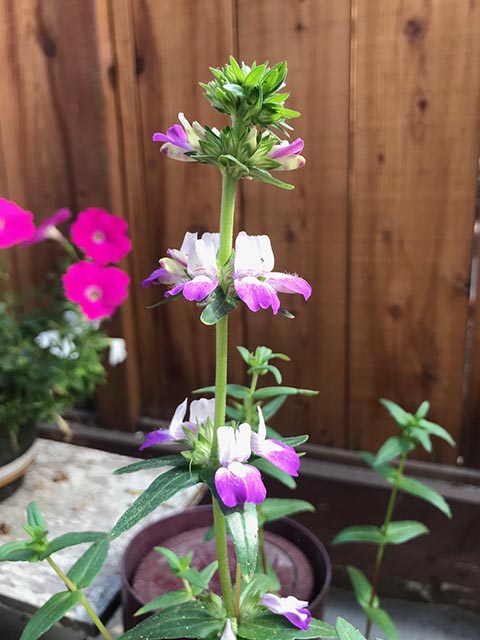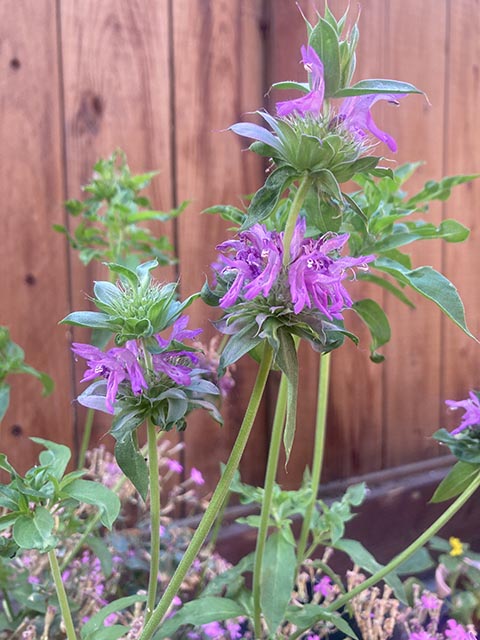How Tall Do Collinsia Heterophylla Grow
According to the ASPCA, Collinsia Heterophylla aka “Chinese Houses” is not toxic to dogs, cats or other pets or wildlife, in fact it is safe for cats and dogs. So you know, we check the flowers we feature on our site with the ASPCA and do extensive internet research for both the common and scientific name just to be super pet safe. If we cannot find direct reference, we check up to genus and so on until we can confirm whether a plant is toxic or non toxic to both cats and dogs. If we are not sure, or get contradictory information, we do not include it. Many of the plants featured we have grown successfully in our own pet safe garden in Northern California. You can see many of garden stars in photos from Lovie’s Pet Safe Garden.
Physical Attributes
- Height: 1-2 feet (30-60 cm) tall
- Flowers: Tiered whorls resembling a pagoda
- Flower colors: White, rose, purple, or violet
- Bloom time: Mid-spring to mid-summer
- Leaves: Bright green, lance-shaped, clasping the stem
- Stem: Sparsely leafy, often covered with velvety fuzz
- Plant habit: Annual wildflower

How to Grow Chinese Houses & When to Plant Seeds
General Care Tips
- Sunlight: Partial sun to light shade
- Soil: Well-drained, slightly humusy soil
- Water: Average moisture, moist but well-drained
- Maintenance: Low
- Sowing: Direct sow in fall or early spring
- Spacing: 18 inches (45 cm) apart
- Deadheading: Remove withering flowers to prolong blooming
- Propagation: Easily self-seeds if allowed
What Is The Use Of Chinese Houses Flower
Fun Facts
- Common name “Chinese Houses” comes from the tiered flower arrangement resembling a pagoda
- Native to California and northern Baja California
- Attracts bees, butterflies, and other pollinators
- May serve as a host plant for spring azure and checkerspot butterflies
- There are about 20 Collinsia species, most native to California
- The genus name Collinsia honors Zaccheus Collins, a 19th-century Philadelphia botanist
- Can form permanent colonies where well-established
- Seeds weigh about 1 mg each when air-dried
- Sometimes used as a bulb cover in gardens

Chinese Houses Are Native to California
| Consideration | Answer |
|---|---|
| Container Friendly | Yes, suitable for containers |
| Indoor/Outdoor | Primarily outdoor |
| Sun/Shade | Partial sun to light shade |
| Perennial/Annual | Annual |
| Flowering | Mid-spring to mid-summer |
| Drought Tolerant | Moderately, prefers average moisture |
| Pollinator Magnet | Yes, attracts bees, butterflies, and other pollinators |
| Beginner Friendly | Yes, low maintenance |
| Good Ground Cover | Can be used as bulb cover |
| Good Privacy Screen | No, too short (1-2 feet tall) |
| Invasive/Spreader | Can self-seed and form permanent colonies, but not typically invasive |
| Hearty/Delicate | Relatively delicate annual |
| Rodent Repellant | No specific information available |
| Deer Resistant | No specific information available |
| Native To | California and northern Baja California |
| Ideal States/Regions | California, adaptable to various regions in USDA zones 2-11 |
Citations:
[1] https://www.wildflower.org/plants/result.php?id_plant=COHE
[2] https://larnerseeds.com/products/collinsia-heterophylla-purple-chinese-houses
[3] https://www.applewoodseed.com/product/chinese-houses/
[4] https://www.gardenia.net/plant/collinsia-heterophylla
[5] https://www.anniesheirloomseeds.com/chinese-houses-collinsia-heterophylla/
[6] https://www.wildflower.org/plants/result.php?id_plant=COHE
[7] https://www.gardenia.net/plant/collinsia-heterophylla
[8] https://en.wikipedia.org/wiki/Collinsia_heterophylla
[9] https://larnerseeds.com/products/collinsia-heterophylla-purple-chinese-houses
[10] https://www.everwilde.com/store/Collinsia-heterophylla-WildFlower-Seed.html


